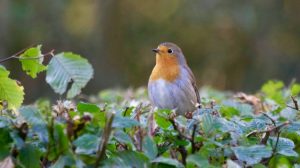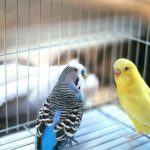Quick Navigation
For most pet parents that feed their cats outside, the situation when wild birds consume their food or water is quite common.
It is also usual for small birds to use water bowls left out for pets as birdbaths.
Whilst it may seem harmless, leaving birds with access to pet food and water can create a number of problems for cats, their owners and the birds themselves.
A primary concern is the potential spread of diseases, as birds often carry deadly bacteria like Salmonella and other harmful organisms like parasitic worms.

Transmission to cats can occur via food and water, through droppings, and direct contact when cats hunt and attack birds.
Infected cats are not only at risk of death, but they can then continue the spread of diseases to humans or other pets.
The birds could become accustomed to the food meant for cats and quit eating the meal that was specifically made for them.
This results in a major disruption to the bird’s typical eating habits.
Additionally, transmission can occur in the opposite direction, with cats spreading diseases they carry to birds.
The consumption of cat meals by birds also produces competition for food, which can leave cats malnourished and create financial burdens on owners if an extra feed is required.
Additionally, more significant losses of wild birds can occur because cats love to hunt birds.
Cat food may be toxic to birds as it is not designed for their nutritional requirements.
To avoid birds banqueting on cat food, some simple measures can be applied, and below is a list of the 7 best ways we found that are easy, practical, and animal friendly.
How To Keep Birds Away from Cat Food
1. Set-up A Feeding Schedule
The access birds have to cat food can be minimized by providing meals at the same time every day for a short period (about 20 minutes).
Also, remove feeding bowls from the outside and cleaning up the feeding area.
It is free and trains cats to eat according to a schedule. Additionally, other wild animals like rodents will also not be able to eat cat food.
2. Get an Enclosed Feeding Station
Enclosed feeding stations with swinging doors can be used to keep birds away and provide a secluded area where cats can feed at any time.
Commercial stations are available, and a cheap DIY version can be made easily by taking a household object like a storage bin, cutting away an entry space on one side, and covering the entrance with a flexible flap.
See Also: Best 6 Dog Treat Dispensers With Camera (Review)
Drinking water can be made available to cats at any time, and it is suitable for pet owners that do not have the time to schedule feedings.
3. Use Bird Repellants
Wind chimes can be installed to chase away birds because they make loud, startling sounds that frighten birds.
Alternatively, an “inaudible” option can be to place ultrasonic bird repellents close to feeding areas.
These devices scare off birds by releasing ultrasonic waves.
They are distressful but harmless to the birds, and they do not have any effects on cats or people.
Wind Chimes and ultrasonic repellents can be easily installed and removed as desired.
Additionally, ultrasonic repellents also deter other animals, such as snakes.
You could make use of a spray designed to deter birds.
Use the spray to cover all of the landing surfaces, including the patio railings and the outdoor furniture.
There are many different types of repellents available, so choose one that is safe to use around the other pets in your home from the variety that is available.
You should be careful not to spray the repellant near or on your cat’s food, though.
4. Place Reflective and Bright Objects Around the Garden
Birds are intimidated by intense flickering lights such as those that bounce off reflective objects.
Metallic garden spinners and fans or other reflective objects like pieces of tin foil, reflective tape, and CDs can be placed or hung around the property to chase birds away.
You can even cover your cat’s bowl with one of these shiny tapes if you like.
Bright balloons and strobe lights can also be used.
It adds sparkle and character to a garden while also keeping birds away.
5. Use Scarecrows and Decoys
Large human or predator-shaped objects are often confused for the real thing by birds, and they go away.
Traditional scarecrows can be used as well as decoy objects that resemble any natural predators of birds.
Good options include plastic replicas of owls and snakes, as well as “hawk” kites (which are kites that resemble hawk silhouettes).
Scarecrows and decoys must be placed in vicinities where birds will see them.
Also, they must be moved around regularly so that the birds do not become accustomed to them and return.
It is creative and uses items that look “at home” in a garden.
6. Get A Dog
Certain dog breeds like sheepdogs love to chase around birds and can be an effective means of keeping birds away.
Let them chase birds during the early mornings and evenings when birds are most active.
Care must be taken to leash and monitor the dogs so that no birds are harmed.
Alternatively, the service and experience of a trained dog handler can be acquired.
What We Love About This Solution
This is an ideal solution for cat parents that are also dog lovers and already have a dog or are looking to get one.
7. Maintain the Garden Area in Good State
A well-kept garden can avoid the presence of birds in general.
Any possible food and water sources must be removed.
Also, remove rubble and anything that can be used for shelter or nesting like heavy thickets and dead logs.
It creates a beautiful garden space to enjoy and keeps away other wild animals in addition to birds.
What is the Best Method?
For the best results, all 7 methods can be used in different combinations and rotations to maintain an element of surprise against birds.
This is because birds are intelligent animals that can be determined to return to the right nesting spot.
All the ideas we provided are doable.
They don’t harm birds; many also chase away other wild animals that may damage gardens or introduce diseases.
While some methods require monetary investment or time, nothing on this list is significantly demanding.
Following these steps will ultimately provide a safe environment for our pets and ourselves!

Purrfect n’ Pawesome is the brainchild of Amanda, who has been into researching and writing about pets to help other pet parents in nurturing their adorable pets. Currently, she runs Purrfect n’ Pawesome along with her team of experienced and dedicated pet experts. Along with being an awesome writer and entrepreneur, Amanda is a cat mom to two innocently spoiled cats, Balanca and Scruffy.
She has been writing about pet care and nurturing and wants to share her readers’ experiences, learnings, and knowledge.
Over the years, she had the opportunity to work with various pet owners having multiple breeds, and that exposure gave her experience and the lessons of a lifetime.
Her family, her entire universe revolves around her two cats, who give her endless support and inspiration to move ahead with her objectives in life. Amanda is a live example of a balanced approach to all parenthood questions we all face in life.






